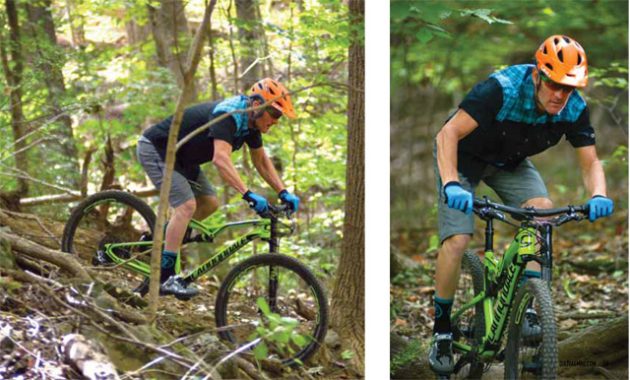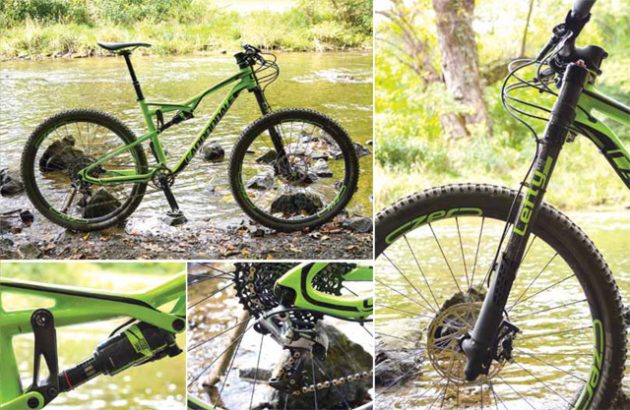Review: Cannondale Habit Carbon 1
Originally posted on March 24, 2016 at 9:00 am
Tester: Mike Cushionbury | Height: 5’10” | Weight: 155 lbs. | Inseam: 32”
Bike sizes: S, M (tested), L, XL | Price: $7,460
Before Cannondale’s new 27.5 Habit had even been released, it gained considerable momentum and interest when WTB/Cannondale rider Jason Moeschler won the coveted “All-Mountain World Championships” in Downieville, California, thanks to a third place in the cross-country and winning the downhill—with a faster time than last year, when he was riding his longer-travel Jekyll.
In Cannondale’s line hierarchy, the 120 mm travel Habit sits between the cross-county-specific Scalpel and the “OverMountain” Trigger, putting it neatly inside the growing trail-bike market, which is often best described as long-travel cross-country. With its linkage suspension and flex seatstays, the Habit looks more Scalpel than Trigger.
Our tester, the Carbon 1, is second highest in the line, below the $12,250 Habit Black Inc. Unless you really want a Shimano Di2 drivetrain and special all-black frame and parts, it represents a much better value and is by all means a top-of-the-food-chain machine.
The 1’s carbon frame comes decked out with a SRAM XX1 rear derailleur mated to an X01 shifter, SRAM Guide RSC brakes and a RockShox Reverb Stealth dropper seatpost. Cannondale, following a growing trend, has gone to in-house branded components and includes some nicely crafted carbon handlebars and a carbon wheelset. The high-end Cannondale HollowGram Si crank even has a Cannondale-branded narrow/wide chainring bolted on. All these bits did their designated jobs just fine. The wheels aren’t super light, coming in at a more trail-bike construction and weight with a 23 mm inner diameter, which is good for the bike’s intended usage.
The entire frame is built from Cannondale’s own BallisTec carbon with an injection-molded carbon shock link. The zero-pivot flex seatstays reduce weight compared to pivots and are claimed to provide greater lateral stiffness. Additionally, the swingarm rotates on oversized thru-axles. This combination results in a rear triangle that doesn’t twist or flex under the most extreme lateral loads.
True to its Downieville debut, the Habit is a speedy trail bike when it’s time to put the power to the pedals, helped of course by its low weight, RockShox XLoc Full Sprint lever—which simultaneously opens or locks out the Lefty 2.0 Carbon fork and RockShox Monarch DebonAir XX shock. While there is the suspension-lockout option, the tuning of the fork and the rear suspension’s leverage curve are designed to work well under pedaling power while in open mode.

The Lefty 2.0 has a new 50 mm offset, wider rebound-damping range from the XLR Isolated Damper, and a Trail+ tune, which has increased compression damping at the top of the stroke. Where previous Leftys sunk into their travel and felt immediately squishy, the 2.0 sits higher, resists brake dive and offers a small degree of firmness off the top while pedaling. It also has a sensitive blow-off valve that opens initial compression when a bump is hit.
It took me a little more time to find an air pressure I was happy with compared to previous generations, but once I did, the new tune felt noticeably better than its most recent predecessor, a fork that was already one of my favorites.
And forget any preconceived notions about flex—Lefty is about the stiffest fork on the market, with its dual clamps, massive stanchion overlap and a 15 mm to 25 mm tapered axle. It’s also one of the lightest forks made.
The rear-suspension leverage ratio is designed to be comfy off the top for small impact sensitivity, especially while climbing, to keep the rear wheel glued to the ground. It then becomes more progressive at the sag point to reduce pedal bobbing. All this is important for a trail bike, whose rider is likely to want to ride it mostly in the unlocked position for the best possible traction in all conditions. But, if need be, with the push of a hydraulic button, both can be locked out for maximum efficiency on smoother surfaces.
Shoot the Habit downhill and it immediately feels quick and springy. The low bottom bracket, short chainstays, 68-degree head angle and stiff frame and fork allow you to push the Habit harder than you’d expect from a bike with just 120 mm of travel. A long top tube matched to a 60 mm stem feels just right for long saddle days that require some pedal finesse as well as competent gravity chops.
While it’s not necessarily a dedicated enduro bike or all-mountain crusher, it can be ridden very aggressively, especially at high speeds where your wheels are a little closer to the ground rather than when monster hucking. The Habit isn’t full cross-country race like the Scalpel but it can do the job with comparably plusher suspension, nor is it a full Enduro World Series race machine like the Trigger but on smoother, more pedaling courses it can deliver a win.
This profile plants it firmly between the two—capable and broad in scope for riders who identify with both disciplines. When it comes to the new breed of highly efficient trail bikes that can climb as well as descend without trading ability at one for the other, the Habit’s geometry, aided by incredible stiffness and solid suspension performance, puts it on the shortlist of bikes you should check out.
- Wheelbase: 47.7″
- Top Tube: 23.4″
- Head Angle: 68°
- Seat-Tube Angle: 74º
- Bottom Bracket: 13.1″
- Rear Center: 17″
- Weight: 24.5 lbs. w/o pedals (specs based on size tested)